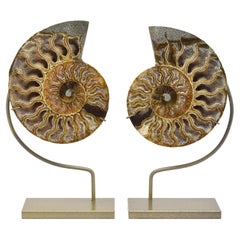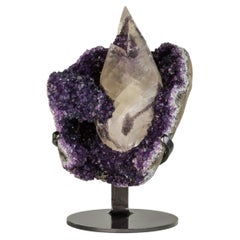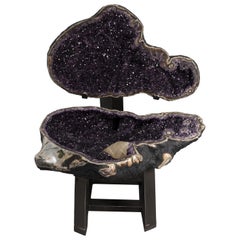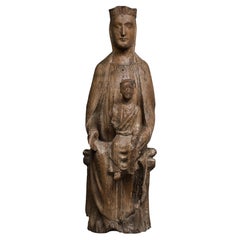15th Century and Earlier Decorative Objects
Uruguayan Antique 15th Century and Earlier Decorative Objects
Agate, Amethyst, Quartz
Malagasy Other Antique 15th Century and Earlier Decorative Objects
Stone
Uruguayan Antique 15th Century and Earlier Decorative Objects
Agate, Amethyst, Quartz
Uruguayan Antique 15th Century and Earlier Decorative Objects
Agate, Amethyst, Quartz
Antique 15th Century and Earlier Decorative Objects
Oak
Chinese Antique 15th Century and Earlier Decorative Objects
Crystal, Rock Crystal
Thai Organic Modern Antique 15th Century and Earlier Decorative Objects
Stone
North African Antique 15th Century and Earlier Decorative Objects
Stone
Algerian Antique 15th Century and Earlier Decorative Objects
Stone
North African Antique 15th Century and Earlier Decorative Objects
Stone
Uruguayan Prehistoric Antique 15th Century and Earlier Decorative Objects
Amethyst
Egyptian Antique 15th Century and Earlier Decorative Objects
Bone
Japanese Other Antique 15th Century and Earlier Decorative Objects
Pottery
French Gothic Antique 15th Century and Earlier Decorative Objects
Limestone
Mexican Organic Modern Antique 15th Century and Earlier Decorative Objects
Onyx
Chinese Other Antique 15th Century and Earlier Decorative Objects
Pottery
Moroccan Antique 15th Century and Earlier Decorative Objects
Stone
Egyptian Antique 15th Century and Earlier Decorative Objects
Other
Israeli Primitive Antique 15th Century and Earlier Decorative Objects
Pottery
Antique 15th Century and Earlier Decorative Objects
Bronze
American Organic Modern Antique 15th Century and Earlier Decorative Objects
Agate, Quartz, Rock Crystal
Antique 15th Century and Earlier Decorative Objects
Other
American Organic Modern Antique 15th Century and Earlier Decorative Objects
Organic Material
Brazilian Prehistoric Antique 15th Century and Earlier Decorative Objects
Rock Crystal
Uruguayan Organic Modern Antique 15th Century and Earlier Decorative Objects
Amethyst
Uruguayan Antique 15th Century and Earlier Decorative Objects
Agate, Amethyst, Quartz
German Gothic Antique 15th Century and Earlier Decorative Objects
Wood
American Antique 15th Century and Earlier Decorative Objects
Stone
European Organic Modern Antique 15th Century and Earlier Decorative Objects
Shell, Organic Material
Moroccan Antique 15th Century and Earlier Decorative Objects
Other
Antique 15th Century and Earlier Decorative Objects
Wood
Central American Pre-Columbian Antique 15th Century and Earlier Decorative Objects
Terracotta
American Antique 15th Century and Earlier Decorative Objects
Other
North African Antique 15th Century and Earlier Decorative Objects
Stone
American Antique 15th Century and Earlier Decorative Objects
Other
Chinese Antique 15th Century and Earlier Decorative Objects
Crystal, Rock Crystal, Copper
Uruguayan Antique 15th Century and Earlier Decorative Objects
Agate, Amethyst, Quartz
Italian Renaissance Antique 15th Century and Earlier Decorative Objects
Wood, Paint
Japanese Other Antique 15th Century and Earlier Decorative Objects
Pottery
Peruvian Antique 15th Century and Earlier Decorative Objects
Crystal, Pyrite, Other
Moroccan Antique 15th Century and Earlier Decorative Objects
Other
Japanese Other Antique 15th Century and Earlier Decorative Objects
Pottery
American Organic Modern Antique 15th Century and Earlier Decorative Objects
Shell, Organic Material
Moroccan Antique 15th Century and Earlier Decorative Objects
Bone
Egyptian Egyptian Antique 15th Century and Earlier Decorative Objects
Wood
Italian Other Antique 15th Century and Earlier Decorative Objects
Pottery
Brazilian Antique 15th Century and Earlier Decorative Objects
Crystal, Quartz, Rock Crystal, Bronze
Antique 15th Century and Earlier Decorative Objects
Cement, Other
Czech Antique 15th Century and Earlier Decorative Objects
Other
Italian Classical Roman Antique 15th Century and Earlier Decorative Objects
Marble
French Antique 15th Century and Earlier Decorative Objects
Bronze
German Gothic Antique 15th Century and Earlier Decorative Objects
Wood
Uruguayan Antique 15th Century and Earlier Decorative Objects
Agate, Amethyst, Quartz
Antique 15th Century and Earlier Decorative Objects
Other
Antique 15th Century and Earlier Decorative Objects
Oak
Libyan Antique 15th Century and Earlier Decorative Objects
Glass
Italian Antique 15th Century and Earlier Decorative Objects
Rock Crystal
Antique 15th Century and Earlier Decorative Objects
Other
American Antique 15th Century and Earlier Decorative Objects
Other
Congolese Mid-Century Modern Antique 15th Century and Earlier Decorative Objects
Petrified Wood
Read More
How a Craving for Color Revolutionized Glass
After synthetic dyes changed fashion, home goods and printed matter, it was only a matter of time till glass caught up.
Kazuyo Sejima’s Flowering Tree Blooms Year-Round
The brilliantly simple design turns a modest bouquet into a major statement.
He Wrote ‘Oedipus Rex,’ but Do You Know What He Looked Like?
The Greek tragedian is said to have been handsome in his day.
Cigar Culture Was Once the Peak of Masculinity. Now, It’s a Compelling Curiosity
Even for those who don’t indulge, elegant smoking accessories and audacious art portraying cigar enthusiasts hold a nostalgic allure.
African Travel Plans on Hold? This Ardmore Leopard Vase Brings the Beauty of the Savanna to You
It’s an excellent example of the sought-after ceramics coming out of South Africa’s KwaZulu-Natal province.
With a High-Tech Flagship and Cool Collabs, Lladró Is Breaking the Mold for Porcelain Production
Thanks to its new leadership, the Spanish maker of figurines, busts and lighting is on a mission to update the art of porcelain for the 21st century.
Zoë Powell’s Magnolia 05 Vessel Is Handmade from Clay She Unearthed Herself
The free-form stoneware piece is inspired by the magnolia tree and its associations with home.
8 Ways to Breathe New Life into a Space with Plants
The pair behind the Instagram account @houseplantclub share their tips for making any room of the house gloriously green.





